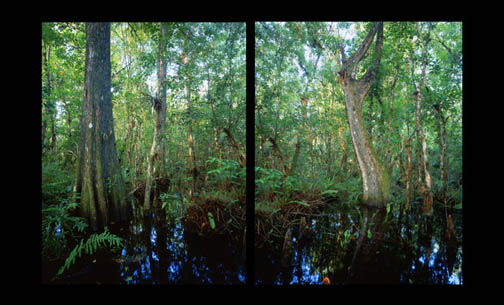
Widespread Effects of Wetland Loss

Wetlands act as the biological "kidneys" of the landscape by filtering out any water that would otherwise directly run into a water system (Mitsch 1993, Mitsch and Gosselink 2000). The loss of wetlands can cause the change in water chemistry of major water systems that those wetlands would otherwise filter out. With increasing transmissions from cars, fertilizer and pesticide use, and animal grazing there are increasing number of pollutants entering our waterways. These pollutants are changing the natural balance of nutrients in our lotic systems and having long-term consequences on the function and community composition of those systems (Ribaudo et al. 2001).
One of the most well known cases of upstream water nutrient loading having a major effect on downstream water sources
occurs in the Mississippi River and the Gulf of Mexico. Nutrients from fertilizer used on farmland and large amount
of sediment from erosion are being washed directly into streams and rivers. Without wetlands, which would filter
out these components from the water, the nitrate, phosphorus, bacteria, and sediment
carried by stream and river systems in the Midwest, run into the Mississippi River. These pollutants ultimately
flow into the Gulf of Mexico, having drastic negative effects on the ecosystem, the principal effect being hypoxia
(Rabalais et al. 1999, Moore et al. 2001).
When large amounts of limiting nutrients, such as nitrogen and phosphorus leech out of soils and into
water systems, the growth of primary producers, such as algae and phytoplankton, increases. This is due to an increased
carrying capacity from the widespread availability of these limiting nutrients. In spring and summer months, when
there are optimal amounts of sunlight, there is an explosion of growth and masses of algae and phytoplankton float
on the surface of the water where the nutrients lie. The oxygen produced by these plants remains on the surface
of the water. Eventually, the algae and phytoplankton fall to the benthic layer, where a layer of dead organic
matter accumulates. Due to the tremendous quantity of this organic material, the decomposer bacteria population
explodes. As the bacteria decompose the dead algae and phytoplankton, they use massive amounts of oxygen, often
depleting the water of it to a point where nothing can live without severe stress or fatal effects. This is how
hypoxia occurs. The technical definition of hypoxia is water with less than 2 milligrams per liter of dissolved
oxygen. In the Gulf of Mexico, hypoxic conditions cover areas the size of Connecticut and make the water uninhabitable
by any aerobic organism, not only affecting fisheries throughout the Southern United
States, but also the entire Gulf of Mexico ecosystem (Rabalais et al. 1999). Had we not drained our wetlands on
the banks of the Mississippi River, these effects could be significantly reduced, if not avoided.

Image of the extent of hypoxia in the Gulf of Mexico in 1999 (Rabalais et al. 1999).
Stream and river chemistry and morphology have been altered drastically as a result
of wetland loss and visa versa. Rivers, streams, and wetlands work as integrated ecosystems to maintain stability
and function. There are several types of wetlands, including riparian, fringe, and instream wetlands, all of which
function to protect and provide nutrients to neighboring streams and rivers (Mitsch 1995, Mitsch and Gosselink
2000). Studies have shown that the effects of riparian zone loss are so great, that the morphology of even large
rivers, such as the Mississippi River, can change drastically. Since 1780, 26 million acres of wetland have been
drained and destroyed on the bank of the Mississippi, resulting in a loss of 25, 800,000 acres of water surface
area that functioned as a hydrologic sink (Hey and Philippi 1995). Not only do pollutants not get filtered out
because of the loss of these wetland sinks, the amount of water that moves into these systems is not regulated.
Therefore, under heavy precipitation, such as the rains of 1993, it is not uncommon for the water velocity and
stage of these lotic systems to greatly increase (Hey and Philippi 1995). The rapid water can lead to the widening
of channels through erosion and, over long periods of time, the straightening of channels. These effects of wetland
loss can also have a great impact on natural events, such as flooding, which occurs more frequently and has more
severe consequences than it would if wetland riparian zones were intact (Mitsch 1993, Rabalais et al. 1999).
Wetland and forest riparian zones provide streams and rivers with organic material, such as leaves, that make up
the waterway's greatest resource of nutrients (Mitsch 1993). Flora, macroinvertebrates, and vertebrates rely on
the area around them for nutrients and food: the riparian area is a source of energy, like the sun, in the trophic
cascade. Without riparian organic matter, these lotic ecosystems have no nutrients
to support the diverse life that they host.
Wetland loss has been associated with the direct loss of species diversity due to destruction and lowered recruitment
of infringing vegetation communities and displacement of fauna (Davis and Froend 1999). Biodiversity is important
in an ecosystem in that it is the multitude of organisms in a system, each having their own role, that drive the
ecological processes (Tilman 1999). The loss of wetlands may end with a loss of flora and fauna, which not only
support human interests, but also contribute to the health of other ecosystems, such as streams and rivers (Mitsch
and Gosselink 2000). The loss of flora is especially devastating in an ecosystem because primary producers, such
as wetland plants, are the basis of any ecosystem. The effects of the loss or lowered recruitment of these plants
ripples throughout the trophic ladder: fauna that depend on wetland plants as a source of food or shelter perish
or migrate, resulting in the loss of fauna that are predaceous, and so on (David and Froend 1999).